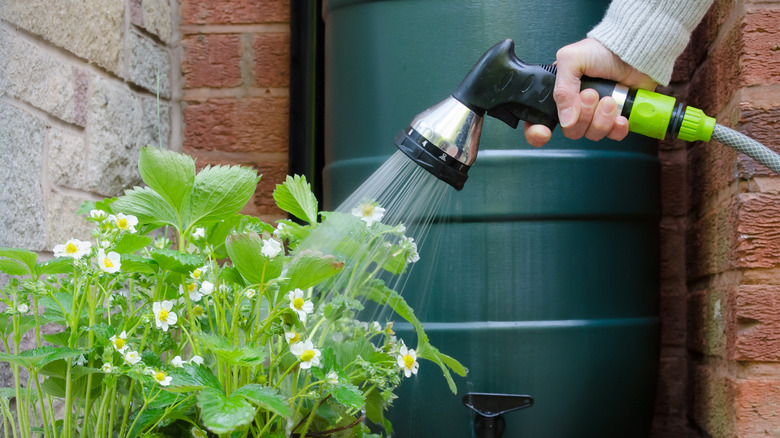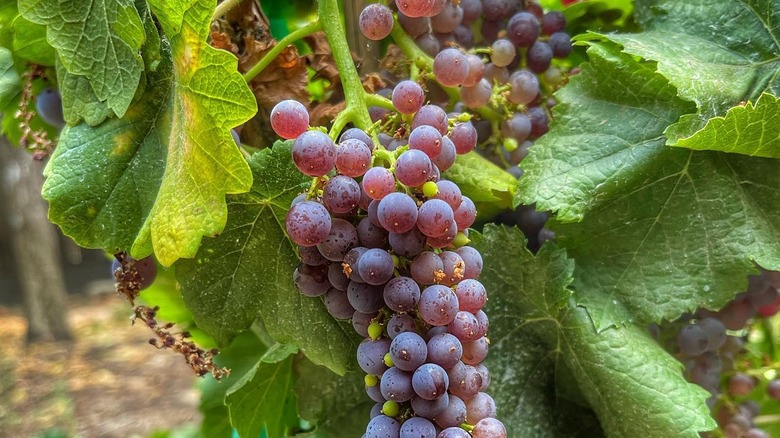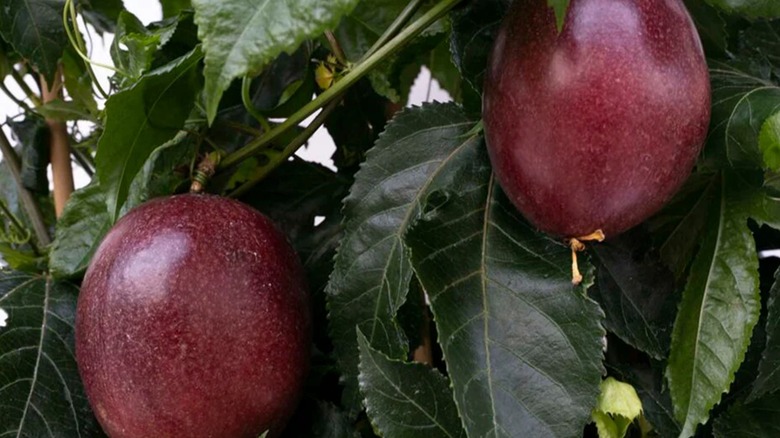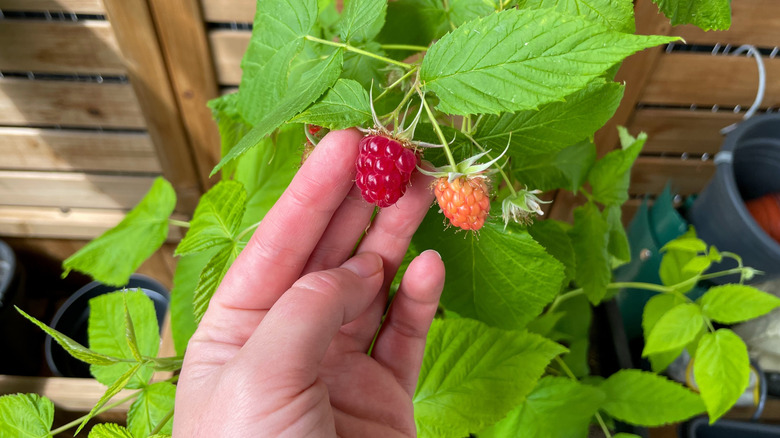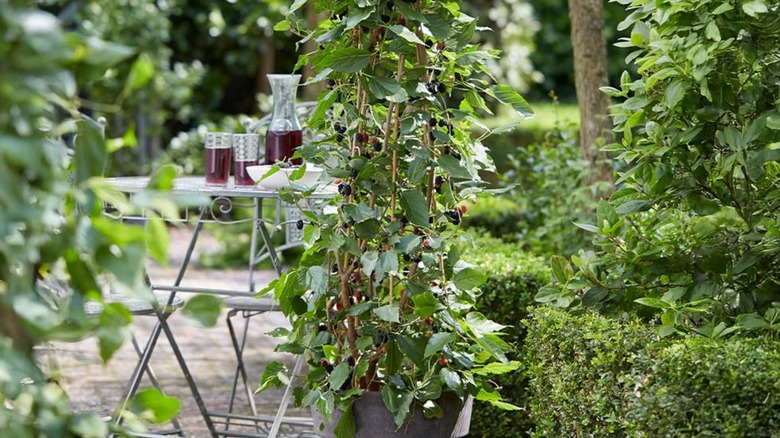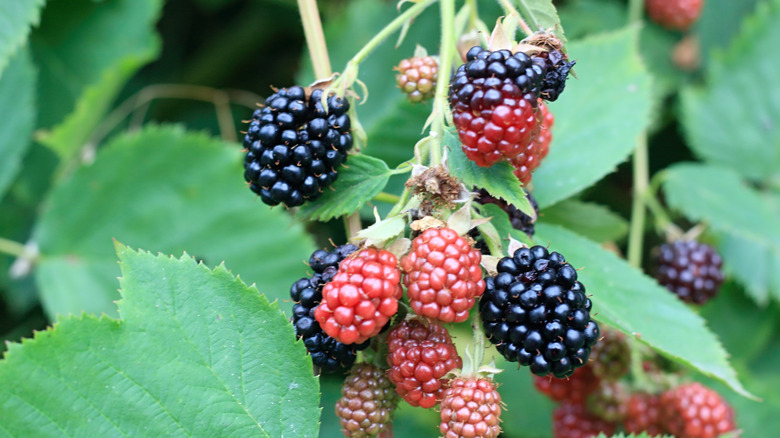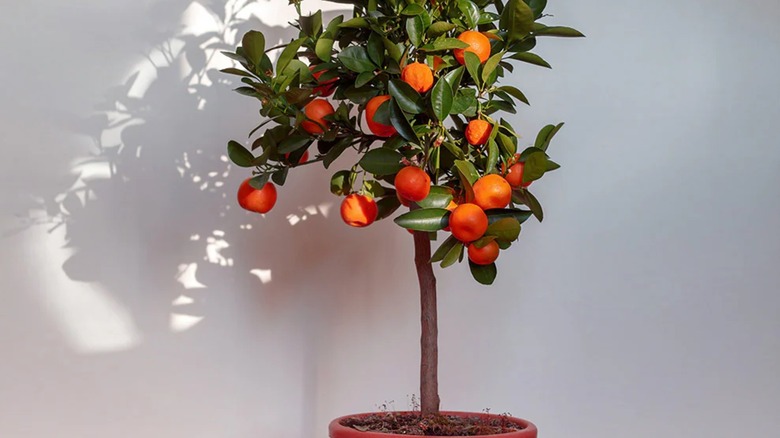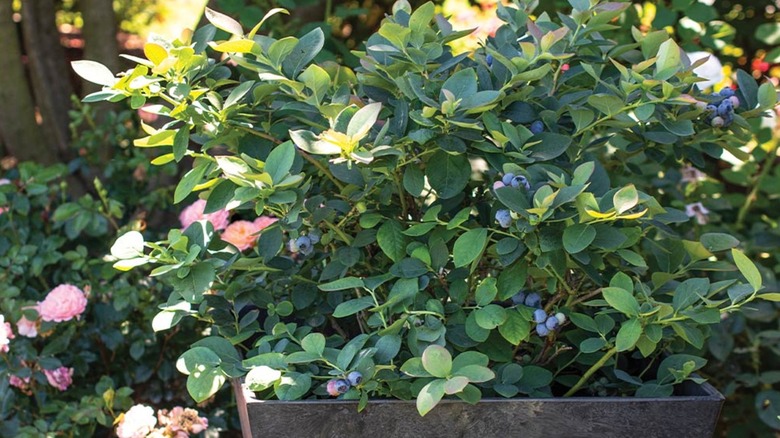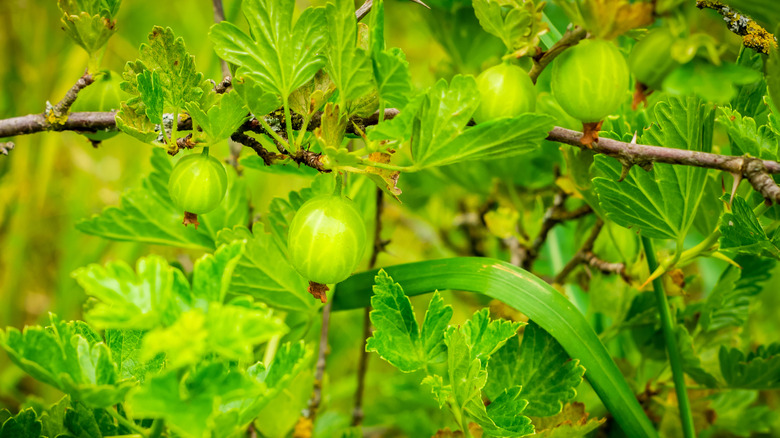No Yard Needed: 15 Fast-Growing Fruits Urban Gardeners Can Grow Easily In A Pot Or Planter
We may receive a commission on purchases made from links.
For many urban dwellers, growing their own fruit orchard feels like a pipe dream. But don't let the lack of a sprawling backyard stop you. As long as you fit in a small pot, you can enjoy many berry plants, including strawberries, pineberries, and blueberries. With a bit more space, you can even plant columnar apples, Cavendish bananas, and citrus trees. Truly, the possibilities are endless if you're willing to put in some work.
While containers address space limitations, there are a few caveats. Due to the limited potting soil, they tend to dry faster. So, to compensate for that, you must water containers diligently, especially during dry summers. Or, install a drip irrigation system to make your life easier. Mulching the roots can help retain moisture, protect them from winter damage, and deter burrowing pests, like squirrels, from messing with your plant. You must also fertilize container-grown plants more frequently, even more so when they're leafing out in spring. As pots put up hard boundaries for root growth, fruit plants can eventually grow unproductive, though you may rectify that through up-potting. With that established, here's a quick roundup of 15 fast-growing fruits worth growing in pots and containers.
In sunny, compact spaces, grow Pixie grapes
While you can grow all grape varieties in containers, Pixie grapes are a superior option. This has to do with their miniature size, which does away with the need for constant pruning. Fully mature, Pixie grapes measure under 2 feet up and across, and can be moved easily when you need to overwinter them indoors. Plus, they're genetically mutated to produce more flowers (hence, the fruit), rather than leafy growth. As a result, they begin production within the first year of planting, sometimes in as little as 12 weeks. Since they're self-pollinating, you can tuck a single pot in a sunny corner and relish the delectable grape bunches throughout summer and fall. But if you'd like to make vintage wine, you'll need more plants. 'Pinot Noir,' 'Cabernet Franc,' and 'Riesling' are excellent options.
Since Pixie grapes are a vining variety, offer them vertical support. If you're getting bare-root plants, plant them directly in a 1-gallon container, like Jeria's 50-Pack Flexible Plant Nursery Pots. They'll need between six and eight hours of direct sun exposure and well-draining, slightly acidic potting soil in USDA Zones 5 to 10.
Figs produce ornamental, edible fruits in planters
Unlike most fruiting plants, figs enjoy being potted. When their roots feel constrained, the plants are stimulated to grow rapidly and produce bigger fruit, benefiting urban gardeners. Plus, figs look ornamental, bearing or not, thanks to their palm-like leaves and bumpy, silver bark. Figs don't require a pollinator and can be grown successfully year-round in Zones 7 to 10. Consider growing 'Brown Turkey,' a fast-growing, self-pollinating fruit tree variety that thrives in containers.
Since fig trees can grow tall — even 'Brown Turkey' can be about 10 feet high — use a sturdy planter that won't topple in strong winds. Otherwise, place it in a protected location that still receives full sun exposure. Rather than planting in a big container, pot up the fig tree when its roots crowd the vessel. This will minimize the risk of rot and pest infestations. In case you choose to grow figs in Zones 6 or colder, move the plants to an unheated garage or basement before frost. Also, note that contact with their sap can irritate the skin, and these plants are toxic to pets.
Get the biggest bang for your space with strawberries
Imagine your patio, balcony, or porch steps decked in ruby gems. With strawberries, your dream can turn into reality. But stick to day-neutral cultivars, such as 'Albion' or 'Everest,' as they're easiest to grow and maintain in containers. Plus, they produce few runners (so less pruning) and bear fruit throughout the summer, promising plenty of pickings. Everbearing varieties like 'Ozark Beauty' that produce a crop twice in the summer are also suitable. To take it up a notch and maximize productivity per square footage, lump different varieties in a vertical planter, like Mr. Stacky's 5-Tier Stackable Planter. However, be sure to water along the sides (and not just the top), so no strawberry plant is left thirsty.
Although strawberries are perennials and hardy in Zones 3 and 4 and can remain productive for about four years, they're usually grown as annuals in pots. That's because they're shallow-rooted and have trouble successfully overwintering if exposed to cold snaps. In case you desire to keep potted strawberry plants alive for next season, mulch the roots and move the pots to a sheltered spot. Long, narrow pots, full sun exposure, and regular fertilization yield the best crop.
Add a tropical touch to pots with Poppin' Passion passion fruit
Perennials in Zones 9 to 11, Poppin' Passion passion fruit (Passiflora hybrid 'Wellington 101') can be successfully grown in containers elsewhere. When not actively fruiting, these vines will brighten the space with their characteristic purple-eyed white flowers. In about 80 days, purple fruits take over, growing sweet as they mature on the vine in the summer heat.
Being tropical, Poppin' Passion grows best when it can access full sun and high humidity. Place the plant against a south-facing wall or in an area that stays warm, allowing the temperatures to stay around 85 degrees Fahrenheit, and not dip below 60 degrees Fahrenheit, if possible. This will improve flowering and fruiting. Also, provide a 5-foot-high trellis to train the vines upward, although you can prune out any disproportionate growth as they're highly tolerant. Offer a blooming fertilizer, like Dyna-Gro's Nutrition Solutions 7-9-5 Plant Nutrient, every month. After harvesting, move the pots indoors and maintain temperatures at 45 degrees Fahrenheit.
Indulge your sweet tooth with fall-bearing raspberries
Raspberries, primarily their primocane-fruiting varieties, can be grown quickly in containers. Also known as fall-bearing or everbearing varieties, primocane-fruiting raspberries start bearing within the first year of planting, usually toward the end of summer or when fall rolls in. In the succeeding years, these plants can be pruned to encourage two harvests during the growing season. For instance, the early-bearing 'Polana' variety produces a second flush in the fall (their first happens in the summer), and is hardy to Zone 4. 'Joan J' and 'Willamette' are other splendid fast-growing options.
Since raspberries develop a deep root system, you can't do that with shallow pots. Instead, plant them in pots at least twice the size of the container they were shipped in (about 2 feet deep). Bare-root plants may be grown in 5-gallon containers, like these Hydrofarm's Pro Cal Round Circle 5 Gallon Wide Nursery Pots. Give them full sun, though protect them from the harsh afternoon heat if it's a particularly hot summer. Raspberries should be fertilized in the spring before they produce new canes.
Weave an edible screen with golden kiwi
If you find that the kiwis in your supermarket are too tart for your taste buds, consider growing golden kiwi or Chinese gooseberry (Actinidia chinensis) in your patio planters. These bronze-skinned fruits offer a sweet, citrusy taste — a balanced blend of mango and pear. These vines can easily gain over 8 feet in a single year, necessitating trellis support, but creating a living screen in return. However, they may take up to four years to produce fruit. When started with seed, they may take even longer. So, try buying them as grafted seedlings.
Golden kiwi can be reliably grown in pots in frost-free pockets in Zones 8 to 10. They must be overwintered indoors in cold climates. Choose a 20 to 30-gallon planter, like Bhcorten's Large Metal Square Planter, to fully accommodate their size. Golden kiwis require a male pollinator and must be placed in a sunny area where bees are active to encourage fertilization. Otherwise, you'll need to hand pollinate; a single male flower can fertilize about five female flowers. 'AU Golden Sunshine' coupled with the male pollinator CKS 'Meteor' is a classic combination.
Grow Mojo berry mulberry bush in indoor or outdoor containers
You might not know this, but mulberry trees can actually produce edible fruit. However, because they can grow quite tall, they're best planted in large yards. Still, there's a way to enjoy these flavorful berries by planting dwarf mulberry bushes, like the Mojo Berry (Morus rotundiloba 'Matsunaga'). This variety grows about 7 feet tall and 2 feet across, and can be easily slipped into a patio or deck container. Another benefit? It doesn't require any pollinator. A fast grower, Mojo Berry can start bearing fruit within the first year of planting. Its ability to produce fruits on both old and new wood implies that you get to enjoy the sweet berries intermittently for nearly five months into early fall.
Mojo Berry can be grown both outdoors and indoors. In Zones 7 to 10, where it's cold-hardy, expose the pots to at least half a day of sunlight or more. In winter, mulch the roots to protect them or overwinter them inside. Indoors, keep the plants where the temperatures are maintained above 35 degrees Fahrenheit. MojoBerry is best planted in a 20-inch-wide container.
Looking for something niche? Try pineberry
How about some strawberries, but colored white? Think pineberries (Fragaria x ananassa). These sweet berries carry hints of pineapple and work great in pots, planters, and hanging baskets, especially the everbearing, hybrid cultivar 'Wonderful'. 'Albino' is another fast grower. Moreover, pests give it a miss, thanks to its white skin, leaving you with plenty of berries until frost. Bonus advantage: Hoverflies and bees are attracted to the spring blooms on pineberries.
Pineberries aren't self-fertile and usually need a strawberry plant nearby for pollination. Such a combination will typically improve the yield on both plants, without any negative impact on the fruit quality. The resultant seeds might not grow true to the parent plant next year, but you can save the runners for propagation. As pineberries maintain a diminutive size, they can be planted in small containers. A 12-inch-wide pot that's about 8 inches deep is optimal. Full sun exposure (at least 6 hours) in Zones 5 to 8 is ideal, but during intense heat, these plants can go dormant without shade protection. If kept indoors or full sun exposure is not possible, pineberries require 10 hours of bright light.
Deck sunny patios in container-grown columnar apples
Don't allow a lack of yard to pour cold water on your dream to bake (and flaunt) Thanksgiving pies from home-grown apples. With columnar apples, you can effortlessly grow your own fruit in a limited space, as most of their varieties stretch about 2 feet wide and 8 feet tall by maturity. While they still need a pollinating companion, it's easy enough to accommodate two apple trees side by side due to their narrow girth. Fast-growing options that yield fruit within the first planting year include cultivars in the Fruit Snacks series, such as 'All Red', 'Tasty Red,' and 'Sweet Treat.' These dwarf varieties are also resistant to apple scab.
Although hardiness levels differ across varieties, usually columnar apples can be grown outdoors in Zones 4 through 9. Potted seedlings should be moved to containers twice their existing size when you receive them. Give them full sun exposure and well-draining potting mixes to help your fruit trees grow and produce faster.
Pop dwarf bananas in pretty containers
Bananas are another tropical plant you can successfully grow in planters — both outdoors and inside. The only downside? They can grow to a considerable height and lugging around 25-gallon containers can be uncomfortable (even if wheeled). So, you're better off choosing dwarf varieties. Think 'Viente Cohol,' which is ready for harvest after six months of planting. But if you want supermarket-like taste, look for 'Dwarf Cavendish,' which grows about 8 feet tall (so you'll need a 15-gallon container) and is hardy through Zone 3 and warmer, if overwintered inside. 'Super Dwarf Cavendish' is even smaller, at under 3 feet mature height, and is ready to produce fruit a year after planting.
Owing to their origin, banana plants require ample watering (more than the usual norm for container plants), especially during the summer. To shorten fruiting times, you must offer bananas full sun exposure, copious heat, and plenty of balanced fertilizer. If these conditions go unmet, these plants can experience delays in reaching their fruit-bearing age. When moved inside for overwintering, maintain 40 degrees Fahrenheit — it's usual for them to drop their leaves during fall. Grown indoors, bananas require 12 hours of sunlight and well-draining soil.
Dwarf, thornless blackberries look great in barrels
Generally, blackberries aren't the first (or even the top 10) choice for containers. But things are changing on the ground with many breeders producing thornless, compact varieties that are easy to harvest and remain manageable even in pots. For instance, 'Baby Cakes' bear bunches of tasty berries twice in the growing season, starting in the summer, and again in the fall. Sweet Arc 'Ponca' blackberry is another fast-growing option that maxes out at 6 feet tall and 4 feet wide. Apart from fast growth, blackberries are usually self-pollinating, so you only need one specimen to get started.
To grow blackberries successfully, you will need large pots, zinc tubs, or barrels, say about 22 inches wide. Since they have an extensive root system, the barrels must be at least 2 feet deep. Keep the soil moist, not soggy, and fertilize regularly in spring. For a second flush of berries, remove the old canes to redirect the flow of resources into fruit production. While hardiness levels vary across cultivars, you're best off moving the containers to an unheated basement or garage (away from cold drafts) in the winter.
Bring in Christmas fervor with Dancy tangerine
You can make your Christmas even more special by growing Dancy tangerine (Citrus reticulata 'Dancy'), a super old, Florida-based tangerine of the mandarin orange variety. These heavy bearers produce delicious fruit in the winter months of December and January, becoming the perfect snack for family gatherings. They also produce beautiful white flowers. However, be careful with your selection, because they're available in two different sizes. Standard specimens can grow nearly 15 feet tall, while the semi-dwarf ones max at 10 feet and can be easily pruned to the desired height. You'll also need to thin out your citrus trees for more uniform fruiting. Otherwise, the production will be heavy one year and low in the next. They don't require a pollinator, but will produce more with a companion or if hand-pollinated.
As Dancy tangerine trees can get big, use large containers. They can tolerate partial sun exposure, but showcase their best performance when they receive about eight hours of daily sun. Since they're cold-hardy only up to 32 degrees Fahrenheit, you must move them indoors to a sunny window during fall in Zones 8 and colder.
Add a novel touch to containers with Fukushu kumquat
Another niche fruit variety worth adding to your containers is the Fukushu kumquat (Citrus obovata 'Fukushu'). Also sold as Changshou or Fuzhou kumquat, Fukushu produces tangy-sweet fruits during winter that can be consumed fresh, along with the rind and the seeds. Planted in containers, this thornless plant is forced to assume a compact habit, growing no taller or wider than 6 feet. For this reason, it can be utilized as a specimen or a focal point in small patios or porches located in Zones 4 to 10.
Fukushu kumquat trees require at least eight hours of direct sunlight. Even when overwintered inside in zones where temperatures dip below 32 degrees Fahrenheit, they must be propped in a brightly-lit room. They prefer acidic potting mediums that drain well. New seedlings can be planted in a 5-gallon bucket and can be upsized depending on the growth.
Dwarf blueberries are easy to grow in pots
Blueberries make excellent container specimens. But choose from their dwarf cultivars for the fastest growth. Take 'Blueberry Buckle', for instance. Shaped like a short, 3-foot boxwood, this compact variety looks ornamental throughout due to white spring flowers and pink-turning-purple summer berries. It has a low chill and warm requirement, making it suitable for Zones 6 to 10. Similarly, Bushel and Berry 'Silver Dollar' amps the flavors through pineapple undertones and visual appeal with their silvery foliage. Contrastingly, 'Perpetua' promises a mid-summer and a fall harvest, though it can grow over 4 feet tall. Although all of these varieties are self-fruitful, planting them in pairs or groups will improve harvests.
Start blueberries in containers that are at least 5 gallons and move up to 16-inch-wide pots if they don't keep a compact mound. This way, it'll be easier to keep the soil consistently moist, though adding pine bark to the potting medium should help retain moisture. Blueberries require at least six hours of direct sun exposure and acidic soils. To grow blueberries in containers for a fresh and juicy harvest, mix coconut coir, sphagnum peat, and perlite in a 2:2:1 ratio.
Utilize lightly shaded areas for growing gooseberry bushes
Diversify your fruit palate by including a few berries from the gooseberry bushes (Ribes uva-crispa). They taste both sweet and sour in the same bite, and are perfect for baked goods. The cultivar 'Captivator' is popularly grown as a small fruit bush in containers. The edible berries start off green and transition into burgundy hues with yellow splotches. Better yet, 'Captivator' is nearly thornless, making harvesting easier. It also boasts resistance to powdery mildew, can tolerate frosts, and doesn't require a pollinating companion to bear fruit.
To get berries within the first year, purchase nursery starts, as seed-grown gooseberries can take up to three years to become productive. Gooseberries grow well in light shade, as well as full sun exposure in Zones 3 to 8, though hardiness levels vary across cultivars. Gooseberries can be started in 16-inch-wide containers and potted up gradually as the roots grow (usually concluding with a 10-gallon container). Make sure to grow them in a compost-based substrate.
